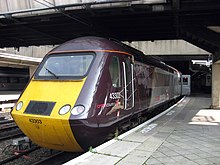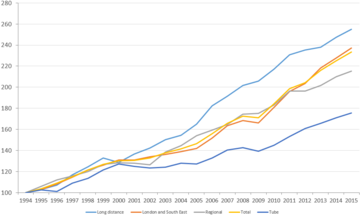Inter-city rail in the United Kingdom
This article needs additional citations for verification. (April 2016) |


In Great Britain, there are inter-city trains to numerous parts of the country. Most of these trains are high speed, and some operate into France, Belgium and the Netherlands.
Before the sectorisation of British Rail, inter-city trains were operated by InterCity. InterCity ran trains from London to South West England, Wales, the West Midlands, the East Midlands, North West England, Yorkshire and the Humber, North East England, Scotland and East of England. There were also numerous cross-country services, which were inter-city services that traversed several regions and usually avoided Greater London.
The UK's longest direct rail service is operated by CrossCountry from Aberdeen to Penzance, and takes 13 hours 23 minutes to complete.
Inter-city trains from London operate out of the following London terminals:
- London Euston — trains to Wales, North West England, the West Midlands and Scotland;
- London King's Cross — trains to the East Midlands, Yorkshire and the Humber, North East England and Scotland;
- London Paddington — trains to South West England, Wales and the West Midlands;
- London St Pancras International — trains to the East Midlands, Yorkshire and the Humber, France, Belgium and the Netherlands;
- London Liverpool Street — trains to East of England.
The following train operating companies operate inter-city trains in Great Britain (operators marked with an asterisk are open-access operators):
- Abellio ScotRail
- Avanti West Coast
- Caledonian Sleeper
- CrossCountry
- East Midlands Railway
- Eurostar*
- Great Western Railway
- Greater Anglia
- Grand Central*
- Hull Trains*
- London North Eastern Railway
- Lumo*
- TransPennine Express
- Transport for Wales
See also[]
- Rail transport in the United Kingdom
- High-speed rail in the United Kingdom
References[]
- Passenger rail transport in the United Kingdom
